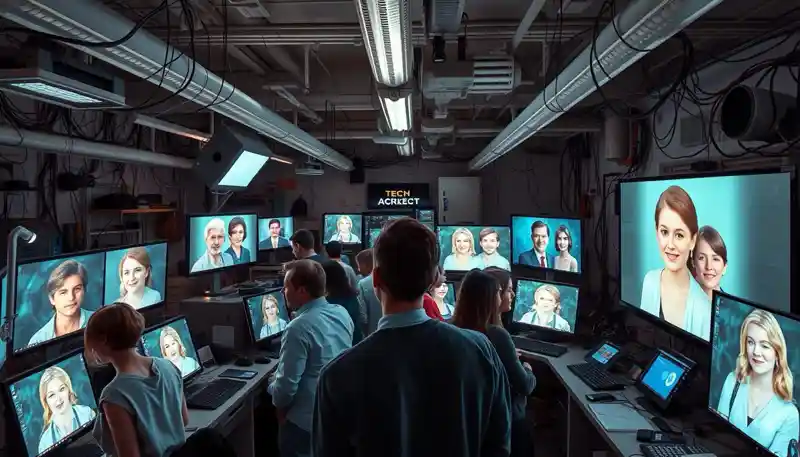Losing a loved one can leave a deep void in your life. New technology now offers a way to bring them back as holographic companions. You can interact with these digital versions of departed family members in your own living room.
This blog will explore the tech behind these holograms and what they mean for grief and memory.
Key Takeaways
- AI uses social media data to create digital versions of departed loved ones, analyzing posts, photos, and messages to mimic personality and speech patterns.
- StoryFile’s technology allows for interactive holograms, starting at £40 for a basic package and up to £400 for advanced options.
- Marina Smith’s hologram appeared at her funeral in June 2022, answering questions from guests using AI and video recordings.
- Experts warn that holographic companions may slow down the grief process and blur reality for older adults with memory issues.
- Users like Kim Kardashian West and participants in the “Meeting You” show have reported emotional experiences with holographic representations of deceased loved ones.
The Technology Behind Holographic Companions

AI brings loved ones back as holograms. The tech uses social media data and voice cloning to create lifelike digital avatars.
How AI Uses Social Media Data
AI systems tap into your social media data to create digital versions of loved ones. These systems scan through posts, photos, and messages you’ve shared online. They use this info to build a profile that mimics the person’s personality and speech patterns.
The goal is to make a chatbot or avatar that feels like talking to the real person.
Your online activity helps shape these digital companions. AI tools analyze your likes, comments, and shared content to understand your interests and relationships. They also look at how you interact with others to capture your communication style.
This data forms the base for creating a lifelike digital version of you or your loved ones.
Ethical Considerations and Public Reception
Holographic companions raise new ethical questions. Privacy concerns and emotional impacts are hot topics in this field.
Privacy Concerns
Privacy concerns loom large with holographic companions for older adults. These AI-powered virtual assistants raise questions about data protection and user tracking. Your personal information, including social media data and voice recordings, may be at risk.
Companies could use this data for targeted ads or sell it to third parties without your knowledge.
Ethical issues also arise from the use of AI companions. The risk of social isolation increases as users may prefer virtual interactions over real ones. You might find yourself spending more time with your holographic companion than with family or friends.
This technology could also lead to misunderstandings about the true nature of these digital relationships. The next section will explore the emotional impacts of using holographic companions.
Emotional Impacts
Holographic companions can stir up strong feelings in users. You might feel comfort and joy when interacting with a digital version of your loved one. These AI-powered holograms use data from social media and other sources to mimic the person’s personality.
This can create a sense of closeness, even after death. Some users report feeling less lonely and more connected to their memories.
But experts warn about possible downsides. Psychologist Mary-Frances O’Connor cautions that grief tech might keep you too attached to the deceased. This could slow down your healing process.
For older adults with memory issues, the line between reality and the digital world might blur. The impact on your grief journey is a big concern for ethicists. Next, let’s look at some real stories from people who’ve used these holograms.
Personal Stories of Users
You’ll find real stories from people who use holographic companions. These tales show how this tech affects lives and helps with grief
FAQs
1. What are holographic companions?
Holographic companions are digital recreations of departed loved ones. They use artificial intelligence to bring back memories in living rooms. These AI-powered avatars can talk and interact, helping with the grieving process.
2. How do companies like Hereafter AI and Replika create these digital beings?
These firms use large language models and user-generated content to build life story avatars. They gather data from text messages, voicemails, and social media posts like Facebook. This helps create a digital version that mimics the person’s speech and behavior.
3. Are there concerns about using this technology for bereavement?
Yes, some worry about unhealthy attachment or parasocial relationships forming with these digital copies. Critics compare it to episodes of Black Mirror, questioning if it’s right to make loved ones “live forever” digitally.
4. How does this tech relate to virtual worlds and the metaverse?
Holographic companions could exist in virtual spaces like Horizon Worlds. As the metaverse grows, these AI avatars might become more common in digital realms, potentially easing loneliness for some users.
5. What role do voice assistants play in this technology?
Voice assistants, powered by AI like ChatGPT or other large language models, can help create more realistic interactions. They allow the holographic companions to respond naturally, making conversations feel more authentic.
References
- https://www.euronews.com/next/2023/03/12/the-rise-of-grief-tech-ai-is-being-used-to-bring-the-people-you-love-back-from-the-dead (2023-03-12)
- https://www.forbes.com/sites/neilsahota/2024/07/18/how-ai-companions-are-redefining-human-relationships-in-the-digital-age/ (2024-07-18)
- https://www.dailymail.co.uk/news/article-12818285/Is-comfort-creepiest-idea-youve-heard-AI-dead-loved-ones-social-media-posts-turn-HOLOGRAM-chat-kitchen.html
- https://news.mit.edu/2021/3d-holograms-vr-0310 (2021-03-10)
- https://digitalcommons.lindenwood.edu/cgi/viewcontent.cgi?article=1479&context=faculty-research-papers
- https://www.ncbi.nlm.nih.gov/pmc/articles/PMC7437496/
- https://www.zocalopublicsquare.org/2020/11/23/hologram-technology-deceased-loved-ones-memory-memorial/ideas/essay/ (2020-11-23)
- https://www.nytimes.com/2022/12/15/technology/personaltech/digital-artifacts-death.html






